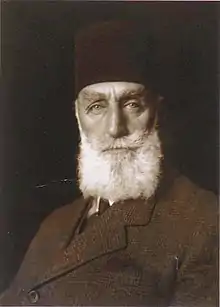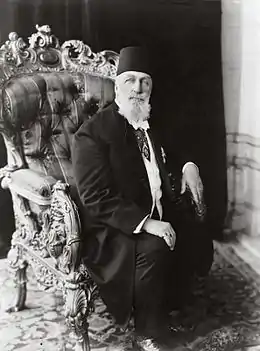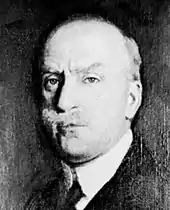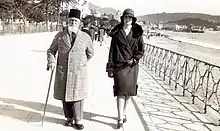Abdulmejid II
Abdulmejid II (Ottoman Turkish: عبد المجید ثانی, romanized: `Abdü’l-Mecîd-i-sânî, Turkish: Abdülmecid Efendi, 29 May 1868 – 23 August 1944) was the last Caliph of the Ottoman Dynasty, nominally the 37th Head of the Ottoman Imperial House from 1922 to 1924.
| Abdulmejid II | |||||
|---|---|---|---|---|---|
| Ottoman Caliph Amir al-Mu'minin Head of the Osmanoğlu family | |||||
 | |||||
| 29th Ottoman Caliph | |||||
| Tenure | 19 November 1922 – 3 March 1924 | ||||
| Predecessor | Mehmed VI | ||||
| Successor | Ottoman Caliphate abolished | ||||
| Head of the House of Osman (in exile) | |||||
| Pretence | 16 May 1926 – 23 August 1944 | ||||
| Predecessor | Mehmed VI | ||||
| Successor | Ahmed Nihad | ||||
| Born | 29/30 May 1868[1][2] Beşiktaş, Istanbul, Ottoman Empire | ||||
| Died | 23 August 1944 (aged 76) Paris, France | ||||
| Burial | |||||
| Consorts | |||||
| Issue | |||||
| |||||
| Dynasty | Ottoman | ||||
| Father | Abdulaziz | ||||
| Mother | Hayranidil Kadın | ||||
| Religion | Sunni Islam | ||||
Early years
On 30 May 1868,[1][2] he was born at Dolmabahçe Palace, Beşiktaş, Istanbul, to then Sultan Abdulaziz and his wife Hayranidil Kadın. He was younger full brother of Nazime Sultan. He was educated privately.
In accordance with late Ottoman custom, Abdulmejid was confined to the palace until he was 40. On 4 July 1918, his first cousin Mehmed VI became Sultan and Abdulmejid was named Crown Prince.[1] When his cousin was deposed on 1 November 1922, the Ottoman Sultanate was abolished. But on 19 November 1922, the Crown Prince was elected Caliph by the Turkish National Assembly at Ankara.[1] He established himself in Istanbul[4][5] on 24 November 1922.
On 3 March 1924, six months after the foundation of the Turkish Republic, the Ottoman Caliphate was abolished and the Ottoman dynasty was deposed and expelled from Turkey.[6][7]
As artist

Abdulmejid was given the title of General in the Ottoman Army, but did not have strong military inclinations. He had a more significant role as Chairman of the Ottoman Artists' Society.
He is considered as one of the most important painters of late period Ottoman art. His paintings of the Harem, showing a modern musical gathering, and of his wife, Şehsuvar Hanım, reading Goethe's novel Faust, express the influence of western Europe in his elite circle.[8] These were displayed at a 1918 exhibition of Ottoman paintings in Vienna. His personal self-portrait can be seen at Istanbul Modern.
Abdulmejid was also an avid collector of butterflies, an activity that he pursued during the last 20 years of his life. His favourite magazine was Revue des deux Mondes.[8]
Personal life




Abdülmecid's first wife was Şehsuvar Hanım, a Turkish.[3] They married on 23 December 1896. She was the mother of Şehzade Ömer Faruk,[9] born in 1898.[10] She died in Paris in 1945,[9] and was buried in Bobigny cemetery. His second wife was Mihrimah Hanım. She died at the Nakkaştepe Palace, on 23 May 1899, and was buried in Nuhkuyusu Mosque, Istanbul.[11][12]
His third wife[3] was Hayrünissa Hanım,[13] a Circassian.[3] She was childless.[13][14] His fourth wife was Mehisti Hanım. She was an Abkhazian. Her father was Akalsba Hacımaf Bey, and her mother was Safiye Hanım. They married on 16 April 1912.[11] She was the mother of Dürrüşehvar Sultan, born in 1914.[15] She died in Middlesex, London in 1964, and was buried in Brookwood cemetery.[16]
Death
On 23 August 1944, Abdulmejid II died at his house in the Boulevard Suchet, Paris. His death coincided with the Liberation of Paris from the German occupation. He was buried in Medina on the recommendation of King Saud of Saudi Arabia.
Honours
- Ottoman honours
- Order of House of Osman, Jeweled[17][18]
- Order of Glory, Jeweled[17][18]
- Imtiyaz Medal, Jeweled[17][18]
- Order of Osmanieh, Jeweled[17][18]
- Order of the Medjidie, Jeweled[17][18]
- Iftikhar Sanayi Medal[17][18]
- Imtiyaz War Medal in Gold[18]
- Outstanding Navy Medal in Gold[18]
- Foreign honours
.svg.png.webp) Austria-Hungary: Grand-Cross Order of Leopold, 6 June 1918[19]
Austria-Hungary: Grand-Cross Order of Leopold, 6 June 1918[19].svg.png.webp) Persia: Order of the Crown, 2nd Class, 23 August 1919[20]
Persia: Order of the Crown, 2nd Class, 23 August 1919[20]
Issue
| Name | Birth | Death | Notes |
|---|---|---|---|
| By Şehsuvar Hanım (married 22 December 1896; 2 May 1881 – c. 1945) | |||
| Şehzade Ömer Faruk | 27 February 1898[21][22][10] | 28 March 1969[21][22] | married twice, and had issue, three daughters |
| By Mehisti Hanım (married 16 April 1912; 7 January 1892 – c. 1964) | |||
| Dürrüşehvar Sultan | 26 January 1914 [21][23][15] | 7 February 2006[21][23] | married once, and had issue, two sons |
Ancestry
| Ancestors of Abdulmejid II | |||||||||||||||||||||||||||||||||||||||||||||||||||||||||||||||||||||||||||||||||||||||||||||||||||||||||||||||||||||||||||||||||||||||||||||||||||||||||||||||||||||||||||||||||||||||||||||||||||||||||||||||||||||||||||||||||||||||||||||||||||||||||||||||||||||||||||||||||||||||||||||||||||||||||||||||||||||||||||||||||||||||||||||||||||||||||||||||||||||||||||||||||||||||||||||||||||||||||||||||||||||||||||||||||||||||||||||||||||||||||||||||||||||||||||||||||||
|---|---|---|---|---|---|---|---|---|---|---|---|---|---|---|---|---|---|---|---|---|---|---|---|---|---|---|---|---|---|---|---|---|---|---|---|---|---|---|---|---|---|---|---|---|---|---|---|---|---|---|---|---|---|---|---|---|---|---|---|---|---|---|---|---|---|---|---|---|---|---|---|---|---|---|---|---|---|---|---|---|---|---|---|---|---|---|---|---|---|---|---|---|---|---|---|---|---|---|---|---|---|---|---|---|---|---|---|---|---|---|---|---|---|---|---|---|---|---|---|---|---|---|---|---|---|---|---|---|---|---|---|---|---|---|---|---|---|---|---|---|---|---|---|---|---|---|---|---|---|---|---|---|---|---|---|---|---|---|---|---|---|---|---|---|---|---|---|---|---|---|---|---|---|---|---|---|---|---|---|---|---|---|---|---|---|---|---|---|---|---|---|---|---|---|---|---|---|---|---|---|---|---|---|---|---|---|---|---|---|---|---|---|---|---|---|---|---|---|---|---|---|---|---|---|---|---|---|---|---|---|---|---|---|---|---|---|---|---|---|---|---|---|---|---|---|---|---|---|---|---|---|---|---|---|---|---|---|---|---|---|---|---|---|---|---|---|---|---|---|---|---|---|---|---|---|---|---|---|---|---|---|---|---|---|---|---|---|---|---|---|---|---|---|---|---|---|---|---|---|---|---|---|---|---|---|---|---|---|---|---|---|---|---|---|---|---|---|---|---|---|---|---|---|---|---|---|---|---|---|---|---|---|---|---|---|---|---|---|---|---|---|---|---|---|---|---|---|---|---|---|---|---|---|---|---|---|---|---|---|---|---|---|---|---|---|---|---|---|---|---|---|---|---|---|---|---|---|---|---|---|---|---|---|---|---|---|---|---|---|---|---|---|---|---|---|---|---|---|---|---|---|---|---|---|---|---|---|---|---|---|---|---|---|---|---|---|---|---|---|---|---|---|---|---|---|---|---|---|---|---|---|---|---|---|---|---|---|---|---|---|---|---|---|---|---|---|---|---|---|---|---|---|---|---|---|---|---|---|---|---|---|---|---|---|---|---|---|
| |||||||||||||||||||||||||||||||||||||||||||||||||||||||||||||||||||||||||||||||||||||||||||||||||||||||||||||||||||||||||||||||||||||||||||||||||||||||||||||||||||||||||||||||||||||||||||||||||||||||||||||||||||||||||||||||||||||||||||||||||||||||||||||||||||||||||||||||||||||||||||||||||||||||||||||||||||||||||||||||||||||||||||||||||||||||||||||||||||||||||||||||||||||||||||||||||||||||||||||||||||||||||||||||||||||||||||||||||||||||||||||||||||||||||||||||||||
References
- Hoiberg, Dale H., ed. (2010). "Abdümecid II". Encyclopædia Britannica. I: A-ak Bayes (15th ed.). Chicago, Illinois: Encyclopædia Britannica Inc. pp. 23. ISBN 978-1-59339-837-8.
- There are sources that give the 29th as the day of his birth.
- Moralı, Seniha Sami (1978). Meşrutiyet, Dolmabahçe Sarayı ve Ankara'nın İlk Günlerine Dair. p. 60.
- The Encyclopædia Britannica, Vol.7, Edited by Hugh Chisholm, (1911), 3; Constantinople, the capital of the Ottoman Empire...
- Inc, Encyclopaedia Britannica (1 May 2008). Britannica Concise Encyclopedia. Encyclopaedia Britannica, Inc. p. 966. ISBN 9781593394929.
- Finkel, Caroline (2007). Osman's Dream: The History of the Ottoman Empire. Basic Books. p. 546. ISBN 9780465008506.
- Özoğlu, Hakan (2011). From Caliphate to Secular State: Power Struggle in the Early Turkish Republic. ABC-CLIO. p. 6. ISBN 9780313379567.
- "The Ottoman caliphate: Worldly, pluralist, hedonistic—and Muslim, too". The Economist. 19 December 2015. Retrieved 26 December 2015.
- Uçan 2019, p. 256-57.
- Uçan 2019, p. 261.
- Uçan 2019, p. 258.
- Haskan, Mehmet Nermi (2001). Yüzyıllar boyunca Üsküdar - Volume 1. Üsküdar Belediyesi. p. 298. ISBN 978-9-759-76062-5.
- Uçan 2019, p. 259.
- Bardakçı, Murat (2017). Neslishah: The Last Ottoman Princess. Oxford University Press. p. 110. ISBN 978-9-774-16837-6.
- Uçan 2019, p. 267.
- Sakaoğlu, Necdet (2008). Bu Mülkün Kadın Sultanları: Vâlide Sultanlar, Hâtunlar, Hasekiler, Kandınefendiler, Sultanefendiler. Oğlak Yayıncılık. p. 713. ISBN 978-6-051-71079-2.
- Yılmaz Öztuna (1978). Başlangıcından zamanımıza kadar büyük Türkiye tarihi: Türkiye'nin siyasî, medenî, kültür, teşkilât ve san'at tarihi. Ötüken Yayınevi. p. 164.
- Alp, Ruhat (2018). Osmanlı Devleti'nde Veliahtlık Kurumu (1908-1922). p. 324.
- Uçan 2019, p. 59.
- Uçan 2019, p. 83-84.
- Adra, Jamil (2005). Genealogy of the Imperial Ottoman Family 2005. pp. 37-38.
- Bardakçı 2017, p. xvi.
- Bardakçı 2017, p. xiv.
Bibliography
- Uçan, Lâle (2019). Son Halife Abdülmecid Efendi'nin Hayatı - Şehzâlik, Veliahtlık ve Halifelik Yılları (PDF) (PhD Thesis). Istanbul University Institute of Social Sciences.
External links
Abdulmejid II Born: 29 May 1868 Died: 23 August 1944 | ||
| Sunni Islam titles | ||
|---|---|---|
| Preceded by Mehmed VI |
Last Caliph of the Ottoman Caliphate 19 November 1922 – 3 March 1924 |
Vacant |
| Titles in pretence | ||
| Preceded by Mehmed VI |
— TITULAR — Sultan of the Ottoman Empire 19 November 1922 – 23 August 1944 Reason for succession failure: Empire abolished in 1922 |
Succeeded by Ahmed Nihad |
| — TITULAR — Caliph of the Ottoman Caliphate 3 March 1924 – 23 August 1944 Reason for succession failure: Caliphate abolished on March 3, 1924 |
Vacant Caliphate abolished in 1924 (The religious position and the official representation of the caliph's powers was transferred to Diyanet İşleri Başkanlığı) | |
.svg.png.webp)